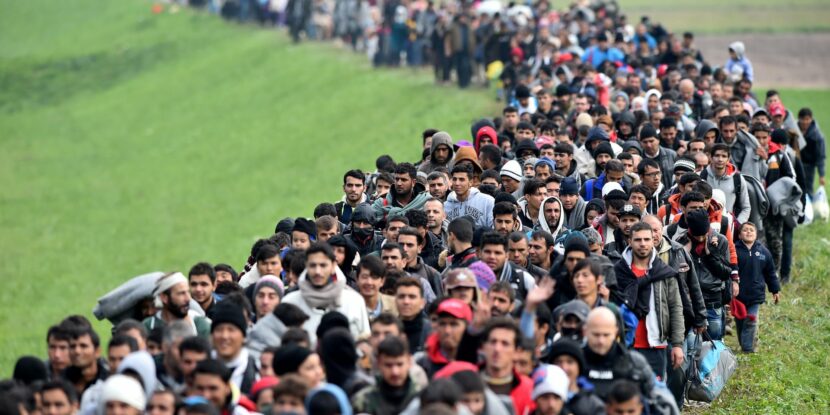With the flash of knife, the latest border-jumping, migrant asylum seeker has wrought yet another trail of blood, hospitalizations, shots fired, and street memorials in a European nation. This time, a 22-year-old Afghan migrant asylum allegedly slashed seven pedestrians in the Swedish town of Vetlanda before police could disable and arrest him.
Although reporting is developing, the Afghan undoubtedly crossed the European Union’s external borders among several thousand young Afghan asylum applicants who traveled to Sweden in recent years via an Iran-Iraq-Turkey-Greece-Italy route and who are now being repatriated as ineligible.
How and why border-crossing migrants from Muslim-majority nations keep conducting such attacks pose lessons applicable to the American southern border, where thousands from the same Muslim-majority nations annually cross.
Jihad at the Border.
As discussed at length in America’s Covert Border War, The Untold Story of the Nation’s Struggle to Prevent Jihadist Infiltration, Europe’s experience showcases a new terrorism travel phenomenon on the world stage: that malevolent long-haul migrants from countries rife with Islamist terrorist organizations now routinely cross land borders of western nations and do so far less noticeably when high volumes of benevolent economic migrants have overwhelmed border management systems.
Security officials first realized the new terrorist border proliferation method after ISIS deployed operatives camouflaged among massive migrant caravans to attack Paris in November 2015 and Brussels in March 2016. Lone offender migrants and small cells have since neatly exploited the inability of western security services to vet hearts and minds as border control and asylum systems stagger under high volumes.
Now that record volumes plague the U.S.-Mexico border, American leaders should know that stressed receiving nations waved through people like the Afghan knife slasher of Vetlanda, the Tunisian who in October 2020 slashed three people in a Nice, France church, the Iraqi who in August 2020 purposefully hunted and killed German motorcyclists in an Opel Astra sedan, Europe’s most-wanted jihadist (captured in Italy in May 2020), the Sudanese migrant who in April 2020 killed two and wounded five more during a knife-slashing spree in the south of France, the five Tajik migrants caught planning to murder American military personnel in Germany, and many others besides.
Indeed, the best available data by researcher Sam Mullins in his book Jihadist Infiltration of Migrant Flows to Europe shows that at least 140 border-crossing refugees and migrants—likely an undercount—gamed asylum systems and killed and maimed over a thousand Europeans from 2011 to 2018. My research for “America’s Covert Border War” identified a likely undercounted 104 border-crossing migrant terrorists from 2014 to 2018. The numbers have since moved only higher.
Opening Europe to Catastrophe.
Europe’s crisis began in 2014 when the Syrian war spurred large-scale migration to the 27-member European Union’s common external borders. Tension built around the question: Will Europe let them in?
On August 24, 2015, German Chancellor Angela Merkel answered yes, we’ll take a million. Embedded in her message was a liberal progressive ideology of multiculturalism, that this was a virtuous, new kind of Germany that, pointedly unlike the old one, would happily import religious and racial diversity over the borders into Europe’s most prosperous economy. The Muslim world heard her message. Millions more immediately entered the pipeline and never really stopped coming.
In naming Merkel Person of the Year in December 2015, Time Magazine regaled her decision as “astounding” in that “the most generous, openhearted gesture of recent history blossomed from Germany, the country that within living memory blew apart the European continent and then the world by taking to gruesome extremes all the forces its Chancellor strives to hold in check: nationalism, nativism, self-righteousness, reversion to arms.”
Progressive liberal leaders and parties quickly brushed off scattered warnings about importing a terrorism threat over the borders as the xenophobia Merkel meant to vanquish. Reporters put other European leaders to the virtuosity test: Would they, too, demonstrate a commitment to humanitarian multiculturalism?
The answer was yes to that and no to the cruel, white tribalism of Old World Europe.
“Everyone must understand: you can’t ask for solidarity when there’s a problem and then exempt yourself from doing your duty when there’ a solution,” French President Hollande said a few months before the coordinated November 2015 suicide bombings that left 130 Parisians dead and 500 wounded at the hands of ISIS operatives deployed among the war refugee migrants.
Finnish Prime Minister Juha Sipila even offered one of his own houses to migrants.
“We should all take a look in the mirror and ask how we can help,” the prime minister told an interviewer. As those who favored multiculturalism marched for the migrants in Finnish cities, Sipila tweeted that he wanted to “develop Finland as an open, linguistically and culturally international country.”
Soon enough, 22-year-old Moroccan Abderrahman Bouanane Mechka mounted a running stabbing spree that killed two women and wounded eight more in Finland’s first jihadist attack.
Sweden’s Stefan Lofven tried to shame resisting eastern European governments for what he termed a “selfish approach,” calling their refusals of refugees “incompatible with humane European values.”
“I can understand if you say this crisis is a worry,” the prime minister said in an interview shortly before the Paris attacks. “But to say: ‘This isn’t my problem, we can’t accept Muslims,’ no, I don’t think this is part of our European values, and I can’t understand this kind of attitude.”
He and all of the others came to rue those statements as, for instance, Uzbekistan-born asylum-seeker Rakhmat Akilov, who’d migrated through Poland, plowed a hijacked a beer truck through a downtown Stockholm department store, crushing five shoppers to death and injuring ten others.
Nowadays, Lofven must be getting used to issuing familiar post-attack refrains that have become a sad new kind of genre for all of the European leaders: “Fear and horror should never be allowed to become part of our daily lives,” Lofven said of the Afghan border-crossing knifer.
From Merkel to Biden.
The parallels between European leadership views then and American Democrats now are as striking as the predictable results. Throughout the 2019 Democratic presidential primary campaign, Joe Biden and the other candidates sounded European-style refrains, vying for who would most warmly embrace illegal immigrants—who would most decriminalize illegal border entry, end detentions, halt deportations, and provide fastest paths to citizenship and government health care.
If Democratic Party messaging was pre-2015 Germany, Sweden, France, and Scandinavia, so was the response. Naturally, migrants around the world heard and acted on their talk. A mass migration has followed the Biden win, a tidal wave that has grown exponentially each month since November to 100,000 Border Patrol apprehensions in February. It is now collapsing the system.
Though most are Spanish-speaking, migrants from Muslim-majority nations are among them.
The Biden administration has the precious advantage of forewarning in Europe’s experience. But all signs so far indicate the new administration is going to squander it.


